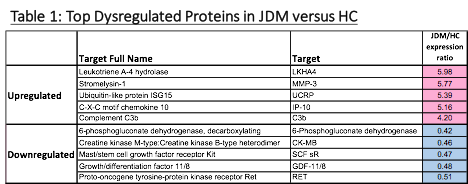Session Information
Session Type: ACR Poster Session C
Session Time: 9:00AM-11:00AM
Background/Purpose: Juvenile dermatomyositis (JDM) is a complex heterogeneous autoimmune disease. Myositis-specific autoantibodies (MSAs), present in up to 80% of JDM patients, help define distinct phenotypes within JDM and may indicate distinct pathogeneses. To define biomarkers and better understand JDM pathogenesis, aptamer-based proteomic technology was used to mine the serum proteome in a well-characterized JDM cohort.
Methods: Sera from 41 JDM patients (prevalent cases on variable treatment) were selected for relatively high disease activity (physician global activity or PGA median 4.0 (IQR 3.0-5.0)) with anti-TIF1 (n=21), NXP-2 (n=10), and MDA5 MSAs (n=10), and compared with 28 age- and gender-matched healthy controls (HC). Broad proteomic analysis of 1306 targets with a slow off-rate modified aptamer-based assay (SomaLogic, CO) generated simultaneous quantitative serum levels. Internal discovery/validation was done with 2 independently-analyzed groups each with JDM and HC sera, stratified to evenly distribute PGA, MSA, gender, oral steroid dose (median oral prednisone dose 0.40 mg/kg/day, IQR 0.17-0.73) and age. From proteins with Mann Whitney U FDR corrected p values of <0.10 (JDM vs. HC) common to both groups with expression ratio of >1.3, we performed Ingenuity Pathway Analysis (Qiagen, CA), as well as exploratory Spearman correlation of protein levels versus PGA, also among MSA groups, and protein levels vs. oral steroid dose (mg/kg/day).
Results: 166 proteins met significance criteria in both analysis groups of JDM versus HC sera, with 80 proteins upregulated and 86 downregulated (see Table). Pathway analysis revealed granulocyte/agranulocyte adhesion/diapedesis, interferon, remodeling/damage, Th1, and adipokines as top dysregulated pathway clusters in JDM, even after excluding 4 proteins that correlated with steroid dosage. We identified 13 proteins with serum levels positively correlated with PGA for JDM overall (rs = 0.31-0.41), 13 proteins in NXP2 Ab group (rs =0.65-0.89), 4 proteins in TIF1 Ab group (rs =0.45-0.54); none in MDA5 Ab group. Individual proteins within MSA groups had stronger correlation with PGA than in JDM overall, and some proteins were only identified in MSA groups (e.g. IFNB in NXP2 Ab group).
Conclusion: Broad quantitative proteomic analysis identified key differentiating pathway clusters in JDM versus HC, including some novel proteins. Several protein levels correlated with PGA, with stronger correlation within MSA groups and notable IFN-related proteins upregulated in the NXP2 MSA group. These proteins identified through a high-throughput screen bring to light pathways that may be important in JDM and potentially MSA-group specific pathogenesis.
This research was supported by the Cure JM Foundation and the Intramural Research Program of the NIH, NIEHS, NHLBI, NIAID, NIAMS and the CC.
To cite this abstract in AMA style:
Kim H, Biancotto A, Cheung F, O'Hanlon TP, Targoff IN, Huang Y, Miller FW, Goldbach-Mansky R, Rider LG. Novel Serum Broad-Based Proteomic Discovery Analysis Identifies Proteins and Pathways Dysregulated in Juvenile Dermatomyositis (JDM) and Myositis Autoantibody Groups [abstract]. Arthritis Rheumatol. 2017; 69 (suppl 10). https://acrabstracts.org/abstract/novel-serum-broad-based-proteomic-discovery-analysis-identifies-proteins-and-pathways-dysregulated-in-juvenile-dermatomyositis-jdm-and-myositis-autoantibody-groups/. Accessed .« Back to 2017 ACR/ARHP Annual Meeting
ACR Meeting Abstracts - https://acrabstracts.org/abstract/novel-serum-broad-based-proteomic-discovery-analysis-identifies-proteins-and-pathways-dysregulated-in-juvenile-dermatomyositis-jdm-and-myositis-autoantibody-groups/

